
Hornbills are birds found in tropical and subtropical Africa, Asia and Melanesia of the family Bucerotidae. They are characterized by a long, down-curved bill which is frequently brightly coloured and sometimes has a horny casque on the upper mandible. Hornbills have a two-lobed kidney. They are the only birds in which the first and second neck vertebrae are fused together; this probably provides a more stable platform for carrying the bill. The family is omnivorous, feeding on fruit and small animals. They are monogamous breeders nesting in natural cavities in trees and sometimes cliffs. A number of mainly insular species of hornbill with small ranges are threatened with extinction, mainly in Southeast Asia.
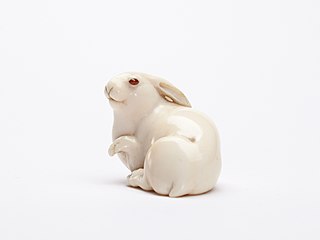
A netsuke is a miniature sculpture, originating in 17th century Japan. Initially a simply-carved button fastener on the cords of an inrō box, netsuke later developed into ornately sculpted objects of craftsmanship.
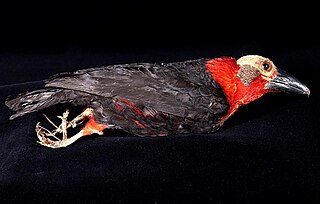
The Bornean bristlehead, also variously known as the bristled shrike, bald-headed crow or the bald-headed wood-shrike, is the only member of the passerine family Pityriasidae and genus Pityriasis. This enigmatic and vulnerable species is endemic to the southeast Asian island of Borneo, where it lives in small groups in the rainforest canopy.

The Hong Kong Zoological and Botanical Gardens(HKZBG) is one of the oldest zoological and botanical centres in the world, and the oldest park in Hong Kong. Founded in 1864, its first stage was opened to the public in 1871. It occupies an area of 5.6 hectares (14 acres) in Central, on the northern slope of Victoria Peak.

Walden's hornbill locally called dulungan, also known as the Visayan wrinkled hornbill, rufous-headed hornbill or writhe-billed hornbill, is a critically endangered species of hornbill living in the rainforests on the islands of Negros and Panay in the Philippines. It is closely related to the writhed hornbill, but can be recognized by the yellow throat and ocular skin in the male, and the blue throat and ocular skin in the female. Its binomial name commemorates the Scottish ornithologist Viscount Walden.

The rhinoceros hornbill is a large species of forest hornbill (Bucerotidae). In captivity it can live for up to 35 years. It is found in lowland and montane, tropical and subtropical climates and in mountain rain forests up to 1,400 metres in Borneo, Sumatra, Java, the Malay Peninsula, Singapore, and southern Thailand.
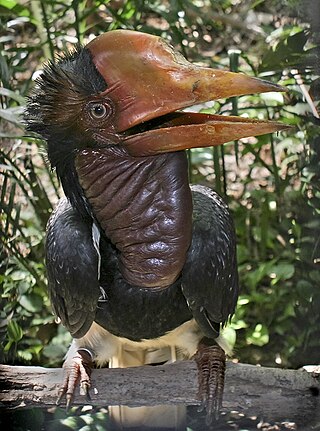
The helmeted hornbill is a very large bird in the hornbill family. It is found on the Malay Peninsula, Sumatra, Borneo, Thailand and Myanmar. The casque accounts for some 11% of its 3 kg weight. Unlike any other hornbill, the casque is almost solid, and is used in head-to-head combat among males. It is a belief among the Punan Bah that a large helmeted hornbill guards the river between life and death.

The great hornbill, also known as the concave-casqued hornbill, great Indian hornbill or great pied hornbill, is one of the larger members of the hornbill family. It occurs in the Indian subcontinent and Southeast Asia. It is predominantly frugivorous, but also preys on small mammals, reptiles and birds. It has been listed as Vulnerable on the IUCN Red List since 2018. It is known to have lived for nearly 50 years in captivity. Due to its large size and colour, and importance in many tribal cultures and rituals, the Government of Kerala declared it as the official Kerala state bird.
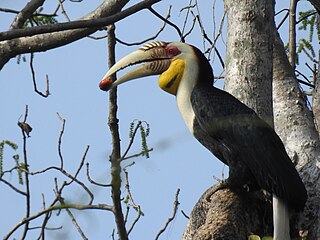
The wreathed hornbill is an Old World tropical bird of the hornbill family Bucerotidae, also called bar-pouched wreathed hornbill due to its distinctive blue-black band on its lower throat sac. It is named after its characteristic long, curved bill that develops ridges, or wreaths, on the casque of the upper mandible in adults. Males are black with a rufous crown, a white upper breast and face, and a yellow featherless throat. Females are uniformly black with a blue throat and are slightly smaller than males.

The uropygial gland, informally known as the preen gland or the oil gland, is a bilobed sebaceous gland possessed by the majority of birds used to distribute the gland's oil through the plumage by means of preening. It is located dorsally at the base of the tail and is greatly variable in both shape and size. In some species, the opening of the gland has a small tuft of feathers to provide a wick for the preen oil. It is a holocrine gland enclosed in a connective tissue capsule made up of glandular acini that deposit their oil secretion into a common collector tube ending in a variable number of pores (openings), most typically two. Each lobe has a central cavity that collects the secretion from tubules arranged radially around the cavity. The gland secretion is conveyed to the surface via ducts that, in most species, open at the top of a papilla.

Batu Lawi is a twin-peaked mountain in the Kelabit Highlands of Sarawak, Malaysia (Borneo) that has played important roles in both ancient mythology and modern history. The taller 'male' peak is 2046 metres above sea level, while the female summit is at 1850 metres. It is one of the highest mountains in the state of Sarawak.
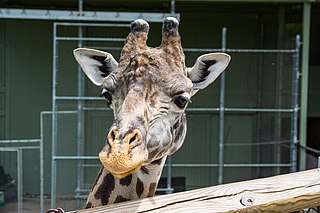
The American Species Survival Plan or SSP program was developed in 1981 by the (American) Association of Zoos and Aquariums to help ensure the survival of selected species in zoos and aquariums, most of which are threatened or endangered in the wild.

The black-and-white-casqued hornbill also known as the grey-cheeked hornbill, is a large black and white hornbill. It has an oversized blackish bill with a large casque on top. The female is slightly smaller than the male and has a significantly smaller casque. It is a monogamous species, and pairs nest in suitable tree cavities. The female usually lays up to two eggs. The diet consists mainly of figs, fruits, insects and small animals found in the trees.
The brown-cheeked hornbill is a species of hornbill in the family Bucerotidae. It is found in Ivory Coast, Ghana, Guinea, Liberia, Sierra Leone, and Togo. Its natural habitats are tropical and subtropical moist broadleaf forests, plantations, and secondary growth forests. It is threatened by habitat destruction, as timber is harvested and the forests become increasingly fragmented.
Casque is a French word for helmet. It can refer to:

Much traditional Chinese art was made for the imperial court, often to be then redistributed as gifts. As well as Chinese painting, sculpture and Chinese calligraphy, there are a great range of what may be called decorative or applied arts. Chinese fine art is distinguished from Chinese folk art, which differs in its style and purpose. This article gives an overview of the many different applied arts of China.
The Zoo Taiping is a zoological park located at Bukit Larut, Taiping, Perak, Malaysia. Established in 1961, is the only zoo in northern Malaysia.

Traditional Malaysian art is primarily composed of Malay art and Bornean art, is very similar with the other styles from Southeast Asia, such as Bruneian, Indonesian and Singaporean. Art has a long tradition in Malaysia, with Malay art that dating back to the Malay sultanates, has always been influenced by Chinese, Indian and Islamic arts, and also present, due to large population of Chinese and Indian in today's Malaysian demographics.

A casque is an anatomical feature found in some species of birds, reptiles, and amphibians. In birds, it is an enlargement of the bones of the upper mandible or the skull, either on the front of the face, or the top of the head, or both. The casque has been hypothesized to serve as a visual cue to a bird's sex, state of maturity, or social status; as reinforcement to the beak's structure; or as a resonance chamber, enhancing calls. In addition, they may be used in combat with other members of the same species, in the gathering of food, or in thermoregulation.















